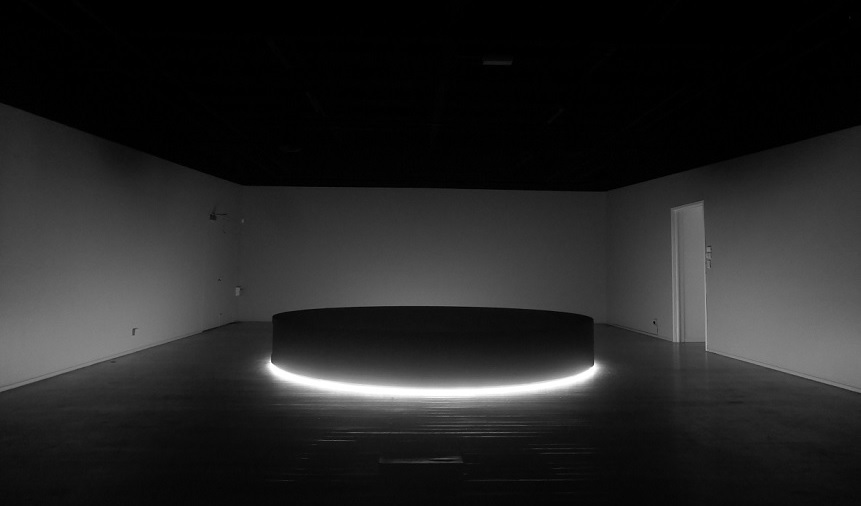Reviews & Articles
塔斯曼尼亞的工業噪音 | Tasmania’s industrial noise
John BATTEN
at 4:27pm on 23rd March 2020


圖片說明:
澳洲塔斯曼尼亞朗塞斯頓,前塔斯曼尼亞鐵路車間內,麥特.華爾德的《死亡中找到我》裝置,2020年3月。(圖片由作者提供)
Caption:
Installation view of Mat Ward’s La morte mi troverà; and, inside the former Tasmanian railways’ workshops in Launceston, Tasmania, Australia, March 2020. (Photos: John Batten)
(Please scroll down for English version)
在塔斯曼尼亞當代藝術館中心處的荷伯特空間,麥特.華爾德(Mat Ward)的聲音裝置《死亡中找到我》(La morte mi troverà)前,我躺在地上細聽環迴聲效,透過地面感受深沉的震動。除了房間另一端圓形高台底部的一線光,室內完全黑暗。場景很有空靈感,就像月球表面,月亮在漆黑荒蕪的懸崖上盤旋一樣。我閉起雙眼靜躺。來自另一世界的聲音呻吟著,深沉的低音隆隆作響,徐徐向高山與低谷進退。這些聲音中有著一種熟悉,可能來自近期的音樂,特別是在低音處,聽出是Sun O)))、Mogwai或Russian Circles那些樂團。樂團年資也顯示了我的年齡,把我帶回了1974年,第一次聽到Peter Hammill以哥德搖滾喉音演繹,收錄於《In Bromine Chambers》專輯的〈Gog and Magog〉,又或者是同期Magma、Can,甚至是Henry Cow等樂隊的作品。他們的音樂挑戰聽覺界限。迷幻和工業音樂都是他們的繼承者。
然而,華爾德《死亡中找到我》的靈感卻來自更早的時代,是音樂想像的關鍵時刻。在過去10年, 華爾德鑽研了意大利未來主義藝術家盧梭羅(Luigi Russolo),後者是早期的噪音藝術家。盧梭羅瞭解到工業化和現代性徹底地改變了我們的聽覺。日常生活已不再單純受制於日照。電燈延長了工作和娛樂時間,我們的活動不再被黎明與黃昏所訂下的宵禁規限。而引擎從最初以水和蒸氣推動,到後來駕馭了柴油與石油的潛在能源,則造就了重工業生產。噪音已變得不再一樣––而且較以往吵鬧,非常的吵鬧。據華爾德解釋,盧梭羅聆聽和相信「音樂的演進直接與科技激增相關,管弦樂團只是過去的遺跡,完全無法產生真正當代音樂需要的聲音。」
在1910至1930年間,盧梭羅製作了名為「intonarumori」的樂器,在意大利文中是噪音生成器的意思。樂器由多個木箱組成,裝有一些可以調節拉力的弦線,透過號角形喇叭擴音。盧梭羅的intonarumori樂團巡迴意大利演奏他創作的噪音作品。是這些新聲音「被公眾藐視,令他們感到困惑 」,情況實是不令人意外。1913年,就在第一次世界大戰完全摧毀優雅的世界之前,盧梭羅撰寫了重要的宣言《噪音的藝術》來解釋和擴充他的想法。
華爾德《死亡中找到我》採用了他自己實地收集的錄音、人聲和各種非音樂的器物。然而,這場展覽的緣起,卻是一場早前為慶祝盧梭羅宣言發表100週年而設的委約表演。華爾德曾體會過一些令他想起「儀式甚至神聖」的聲音。他進一步研究後,發現盧梭羅曾於作品採用術數,這位藝術家更對玄學深感興趣,嘗試以自己的曲目作品接觸亡者。華爾德的黑暗房間、來自另一世界的噪音和神秘的圓形光線,都叫人想到可能被靈體佔據的神秘過去。
2001年,朗塞斯頓維多利亞女皇博物館及藝術館設置了向公眾開放的新翼,以前身為塔斯曼尼亞鐵路鋼鐵工程車間作為中心歷史裝置,車間的歷史可追溯至1870年代。這裡保存得完好無缺,是19世紀工業工作間的完整例子。所有鐵路運作所需要的木工、金屬片和油漆,包括鋼軌、車廂、訊號設備和火車頭,都是由此類車間和其他車間內部製作和維修。車間於1993年關閉,其狀態一直保留下來,就像工人將於明天回來繼續工作一樣。機械和工具放在工作台和儲存架上,等待工人上班時領取。十四個鐵匠和鏇床工人用來加熱和製造鐵路產品的熔爐依然放在原位。身處其中,很容易可以想像到工匠以往在此冒著汗工作的情況,還有當中所產生的噪音:噹噹聲、錘打聲和拖拉聲音,還有滿室的煙和火。
近日的塔斯曼尼亞之旅,我看到了當代聲音藝術和早期工業製造歷史,令我喜出望外。塔斯曼尼亞以其草木鳥獸、獨有的動物和鳥類、原始的國家公園和海灘而為人熟悉。但在這自成一角的地方,自給自足是必需的:工業化不僅影響了世界各地的大都會城市,也可見於全球較遙遠的角落。因此,塔斯曼尼亞藝術家對意大利先鋒噪音藝術家致敬,其實也不突兀。
原文刊於《明報周刊》,2020年3月12日
Tasmania’s industrial noise
by John Batten
I lay on the floor of Contemporary Art Tasmania’s central Hobart space listening to the surround-sound, feeling the deep vibrations coursing through the floor of Mat Ward’s sound installation, La morte mi troverà (In death you will find me alive). The room was entirely dark except for a strip of bright light running around the base of a raised circular dais at one end of the room. The scene was ethereal, like a moonscape with a lunar module hovering on a dark barren escarpment. I closed my eyes, laid-out and still. The sounds groaned from another world, the deep bass rumbled, ebbing towards mountain heights and slowly to valley lows. There is a familiarity to these sounds - in recent music it could be from, certainly in their drone moments, the bands Sun O))), Mogwai, or, Russian Circles. Showing my age, it takes me back to first hearing Peter Hammill’s gothic, guttural Gog and Magog (In Bromine Chambers) of 1974, or, from the same period, such bands, as Magma, Can or, even, Henry Cow. They played music pushing its aural limits. Trance and industrial music are their successors.
But Ward’s La morte mi troverà seeks inspiration from a much earlier time, a pivotal moment in imagining music. Over the last ten years, Ward has studied the Italian Futurist artist Luigi Russolo, who was an early noise artist. Russolo understood that our sense of sound had been fundamentally shifted by industrialisation and modernity. Our days were no longer governed by pure daylight. The electric light had extended work and entertainment outside the strict curfews imposed by dawn and dusk. And engines, first driven by water and steam, then harnessing the latent energy of diesel and petroleum, allowed heavy industrial production. Noise was now different - and, louder, much louder. Russolo listened and believed, as Ward explains, that “the evolution of music is directly related to the proliferation of technology and that the orchestra was a relic of the past which simply could not produce the sounds required for a truly contemporary music.”
Between 1910 to 1930, Russolo built acoustic musical instruments called intonarumori (or, ‘noise-makers’ in Italian) comprising wooden boxes, some containing strings whose tension could be adjusted while being played through a horn giving greater amplification. Russolo’s orchestra of intonarumori toured Italy playing his noise compositions. Not surprisingly, these new sounds were heard “to the disdain and bemusement of the general public.” In 1913, just before World War I and the thorough destruction of a more genteel world, Russolo wrote his seminal manifesto The Art of Noise, to explain and expand on his ideas.
Ward’s La morte mi troverà uses his own field recordings, voices and an assortment of non-musical implements. The inspiration for this exhibition, however, came during an earlier commissioned performance to celebrate the hundredth anniversary of Russolo’s manifesto. Ward had experienced sounds that reminded him of “ritual and ceremony and even the sacred.” Further research showed Russolo’s compositions had employed numerology and that the artist had a strong interest in the occult, using his compositions as a medium to try to contact the dead. Ward’s darkened room, otherworldly noise and a mysterious line of circular light conjures a mysterious past, possibly inhabited by spirits.
Conserved as a historical centrepiece to house an extension of Launceston’s Queen Victoria Museum and Art Gallery in 2001, the former steel engineering workshops for Tasmania’s railways date back to the 1870s and are open to the public. It is an extraordinary intact example of a 19th century industrial workspace. In these workshops, supported by other workshops, such as carpentry, sheet-metal and painting, everything needed for the railways to function was manufactured and repaired in-house: steel tracks, carriages, signalling equipment, and locomotives. Closed in 1993, the workshops have been left as if the workers were to return for work the following day. Machines and tools lie waiting to be picked-up from work benches and from storage racks. The fourteen furnaces used by blacksmiths and turners to heat and work steel to make railway products are still in situ. The sweaty conditions in which the tradesmen worked, and the resulting noise can easily be imagined: banging, hammering, grinding and hauling, amidst smoke and fire.
On a recent trip to Tasmania, the strands of contemporary sound art and early industrial manufacturing history was a surprising experience. Tasmania is usually known for its natural fauna and flora, unique animal and bird life, pristine national parks and beaches. But, in such an isolated place, self-sufficiency was a necessity: industrialisation not only influenced the world’s great urban cities, but was seen in the world’s remoter corners. Thus, a Tasmanian artist’s homage to a pioneering Italian noise artist isn’t so odd after all.
This article was originally published in Ming Pao Weekly on 12 March 2020. Translated into Chinese by Aulina Chan.
